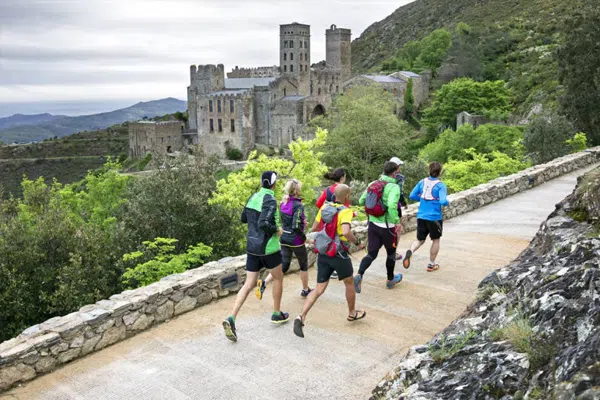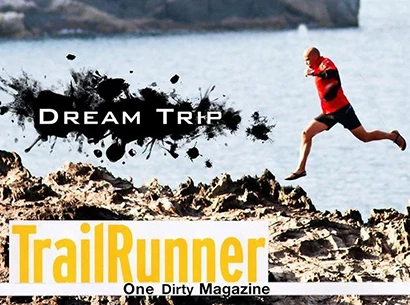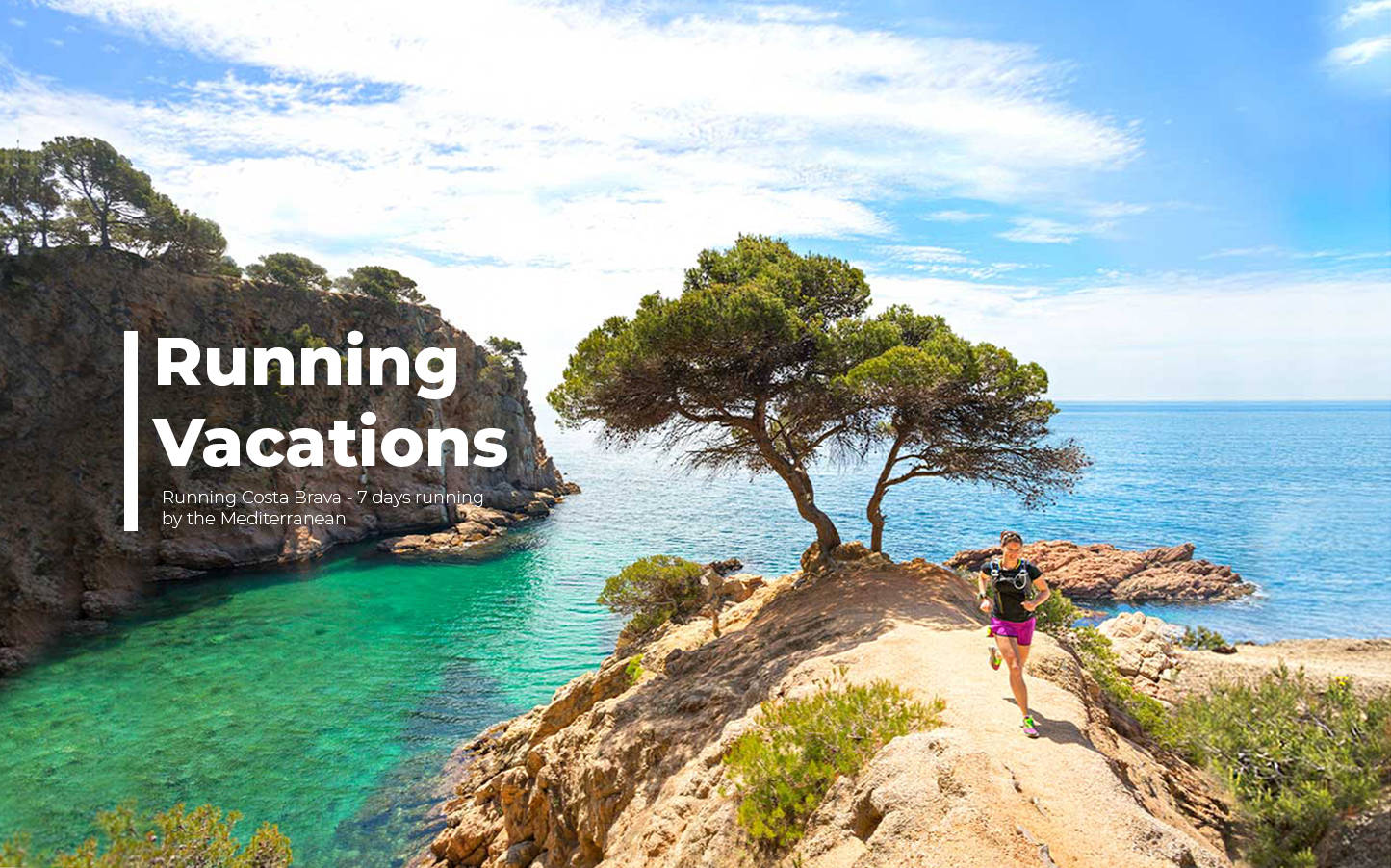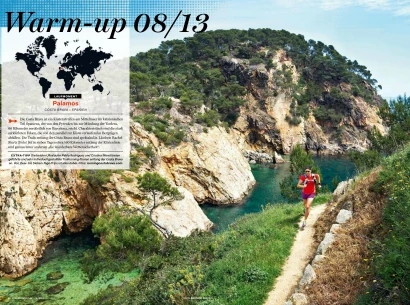Trail running Magazine running vacation
FAQs, Costa Brava, Running Holidays, Running Magazines
Article published in Trail Running Magazine
A trail-running tour of the Costa Brava region of Spain provides an unexpected immersion in Catalan culinary, culture, and history.
Pablo Rodriguez, our Running Costa Brava Tours guide, is instantly recognized in Girona's crowded train terminal. Not because I've met him or seen his picture before; rather, I identify him in the same way that a runner identifies another runner.

Runners love food
Meeting our running guide
Pablo is dressed in a scarlet hydration vest over a sweat-stained technical T-shirt, grey shorts, and pancake-flat yellow running shoes that scream running nerd. When we make eye contact, his bald head sparkles just as brightly as his eyes. He leaps at me, his pace light and springy, like a deer. "Greetings from Catalunya!"" he explains.
Chris Hunter, a photographer, and I will be spending the next four days with Pablo on a fully sponsored Catalonia trail-running trip of the Costa Brava's ancient villages, spas, and wineries between Girona and the French border at the Pyrenees. We'd spent the day before in Barcelona, touring the city's famous La Rambla tourist district and the famous Goudi sites. After spending the night in the city, we boarded an early morning train to Girona, where our tour would begin.

Runners in San Pere de Rodes Monastery
This is about running
The topic of running comes up during the hour-long trip to the trailhead. "Running is not just a sport; it's as natural as breathing," says Pablo, who ditched his shoes in favor of Tarahumara-inspired Luna sandals after reading the best-selling book Born to Run. "Humans don't require much between their feet and the earth. Running barefoot is a sign of weakness."
Then he asks if we've heard of Kilian Jornet, possibly the world's most gifted young trail runner.
"He's Catalonian, you know," Pablo boasts.
While Catalonia (Catalunya in Catalan) is ruled by Spain, Pablo describes it as an autonomous province with a proudly separate culture defined mostly by its cuisine and language. Catalan, which was outlawed until 37 years ago but is currently on all road signs in the region, is spoken by everyone.

Runners love food
More than running
"How long has Catalonia existed as a country?"" I ask.
"Not for long, about 300 years," Pablo replies. I snicker, then realize that 300 years isn't a long period for Catalans. "Someday we will again be our own nation."
Pablo exits the freeway and follows a country road through verdant pastures and large sunflower fields. Then we take a hardly practicable, rocky dirt road uphill past forests of cork trees, the bark of which has been scraped to manufacture bottle corks.
As we get closer to the trailhead, I ask Pablo who looks after the trail system. "Some I made myself using the paths forged by wild boars, but they are low to the ground so I must clear the way for people using my machete," he goes on to say.
"I've gotta see that," Chris says from the back seat.
"Wild pigs?"" I tremble.
"Yes, but not to worry," Pablo assures. "They are harmless."
We disembark at a centuries-old stone chapel amid a beautiful field. In all directions, trails disappear into the forest. We're kilometers from the nearest town, so I'm guessing the faithful trek these routes to attend mass. The smell of salty sea air motivates me to take action. "All right, let's go!"" I yell to Chris, who carefully fits his photographic equipment into a lightweight hydration pack he purchased specifically for this expedition. Chris, who lives in the adventure-sports mecca of Moab, Utah, usually photographs skydivers and BASE jumpers, but he viewed the opportunity to spend a week running and photographing in Spain as equally exciting.
Pablo directs us to one of the trailheads and provides me a GPS gadget with which we will travel the 23-kilometer itinerary for the day. He waves goodbye as he begins driving around the hillside to meet us at our next rendezvous place.
We emerged from a gravel road surrounded by head-high vegetation 45 minutes later onto a sandy knoll sheltered by trees bending in the unrelenting south winds, where Pablo waited waiting. We jump from the knoll and speed along the white-sand beach, passing in front of a dozen wooden boat cottages, each with a bright red, green, blue, or yellow door. These treasured boat shelters, as important to coastal life in Costa Brava as automobile garages in America, are never bought or sold, but are passed down from generation to generation.
The trail follows the cliff tops above the pounding surf, alternating between soft and rough stone steps that ascend and descend the jagged beach. We soon arrived at the gradual, smooth Cami de Ronda, which leads to the gleaming whitewashed, red-tile-roofed homes of Llafranc, which Pablo describes as a "simple" fishing community. Nonetheless, its coastal promenade is lined with gourmet eateries and upmarket retailers.
The instant we step onto Llafranc's cobblestone streets, ominous storm clouds above us unleash a torrential downpour. We sneak into an empty café for drinks and pa amb tomata, a Catalan open-faced sandwich made by pressing a juicy, red tomato half onto fresh, crusty bread and then wrapping it with cured ham slices.

Runners love food
100's of runners before you
"Here, please take my rain shell," Chris suggests.
Pablo, who is only wearing running shorts and a T-shirt, waves away Chris's jacket.
"No, the human body is designed to self-regulate." "I'll see you in an hour," he adds as he dashes barefoot into the pouring rain to retrieve the car.
The next morning, I awake to the sensation of great heat on my face and open my eyes to the sun-filled room at El Far, which was an 18th-century monastery before becoming a hotel.
I put on a fluffy terrycloth robe, open the narrow French doors, and step onto our cliff-top accommodations' balcony. I lean against the wrought-iron railing, listening to the quiet crash of waves on the rocks far below. The Sant Sebasti de la Guarda lighthouse, on the right, overlooks the street where we'd dined the night before on generously seasoned seafood-and-rice paella at Llevant. To the north, there is an unimpeded view of the rocky beach where today's 22-kilometer run will take place.
I descend the huge stone staircase used solely by monks for centuries and take a seat in the solarium for breakfast. To prevent overeating on rich cheeses and cured meats, I opt for fresh fruit, creamy, unsweetened yogurt, and freshly squeezed orange juice.
At 11 a.m., Pablo leads us over well-worn beachside paths that connect a series of pebble-beached coves. We greet hiking couples and beach-goers with the Catalan phrase "Bon dia!"" as we walk by.
As we approach Tamariu, Pablo tells us about his family life with his wife, Cristina, juggling two jobs and living with four energetic youngsters under the age of eight, when he abruptly comes to a halt and turns to face us, a solemn expression on his face. "I may not be the boss at home, but here I am the boss," he said. "Come with me!"
I pause, wondering what he has in store for me. Pablo deviates from the path and bounces from boulder to boulder near the water. He flicks off his sandals, yanks off his shirt, and sprints off the end of a wooden diving board, splashing into the ocean.
I've gotten to know Pablo well enough to know he's not going to let me off the hook. I reluctantly take my bag off and unlace my shoes. My hyper-efficient inclinations, which serve me well in ultramarathons, kick in, and I am irritated by the delay. After all, we'd only traveled a few miles and had a long way to go. Chris races past me and excitedly takes the plunge as I stand there wondering. But my clothing will be wet, I'll have to change, and I'll have to reapply sunscreen, and we still have a long way to go...
The jolt of falling into the chilly sea is the slap in the face I deserve. I giggle at myself as I drag myself onto the rocks, water flowing from my clothes. Remember, Elinor, you're on vacation; there's no agenda, no goal.
Chris and I follow the GPS's arrow leading us inland after changing into dry clothing at the car. We miss the cool wind of the seaside and the heat of the sun. Our feet sink into the sand as we go through a tree plantation. As we climb, the trail becomes firm doubletrack surrounded by natural woodland. We zoom down the other side of the hill after cresting it, until we reach a pancake-flat road that leads us to the medieval city of Pals.
Cars and paved roads are replaced by walkers and tiny cobblestone streets as they traverse the historic stone defenses that encircle Pals, purportedly Christopher Columbus' port of departure. Being in Pals is like traveling back in time. The Torre de les Hores, a 13th-century Romanesque tower in the heart of its wonderfully restored Gothic Quarter, is where sentries would survey the horizon for pirates and other invaders.
We're doing everything we can to catch up with Pablo as he darts into streets so narrow that my outstretched hands touch the buildings on either side. He comes to a halt in front of a small wooden door and beckons for us to have a seat at one of three narrow metal tables out front.
"We've arrived!"" he proclaims.
Chris and I exchange glances, unsure what "here" means.
"Our run for the day is finished; now it's time for beer!""
We clap and walk through the narrow entryway into a space just big enough for a bar and a row of bar stools. We order three Estrella Damm Catalan pilsners and sit outside in the pleasant sun.
Pablo soon tells us that the day isn't done; we have a spa appointment. Mas de Torrent, a premium hotel in the famed Relais & Château Group, is only a short drive away. We take a stroll across the hotel's groomed grounds to Mas Spa, a zen-inspired ultra-modern spa nestled in a verdant garden. Hot-water jets massage my fatigued muscles for the next two hours, an ice-cold plunge pool flushes the soreness from my joints, and rosemary-infused bath products invigorate my senses.
Later that evening, we drive to Mas Camangau hotel in nearby Begur, where the proprietor, Miguel, greets us as if we were old friends. His grey-streaked hair is pulled back into a short ponytail, and his cheekbones are as round as his glasses. The 200-year-old farmhouse-turned-boutique hotel has a comfortable yet regal feel thanks to grey stone archways framing the entry to each room.
Miguel walks us through a back door and down some steps to a garden patio. "Your room is in the back, where the horses were kept," Miguel jokes. The ancient barn-wood door with iron hardware leads to a beautiful room with vaulted ceilings and modern facilities.
Chris and I take our seats in the hotel restaurant at what would typically be my bedtime, where Miguel says that he has prepared a special tasting menu for us. The first mouthful of fish ceviche with vichyssoise sets the tone for a five-course feast of Catalan specialties. We savor bites of hand-made aubergine ravioli topped with mussels and rosemary between gulps of local red wine, then delicate fish filets on a tomato purée topped with olive tapenade and chives, followed by thinly sliced roasted duck topped with a sweet sauce made with strawberries, raspberries, and sherry.
Every dish contains components from the area as well as a personal link to Miguel or his family.
"The father of my brother's wife grows this melon," Miguel says proudly as our waitress brings us two pieces of bisbalen, a Catalan melon-jam-filled pastry sprinkled with powdered sugar. "And it tastes even better with this," he continues as he pours a sweet-smelling, transparent liqueur into two shot glasses.
"Oh no! Not for me!"" I say, planning my run for tomorrow.
"Well, I can't say no," Chris adds as Miguel re-fills his glass.
The next morning, we drive to Figueres, our first significant town since leaving Girona, to see the Teatre-Museu Dali, a museum dedicated to Salvador Dali's strange art work. Dali, a true Catalan, affected his art in surprising ways, with his favorite meals showing in sculptures and paintings.
After an hour of meandering through the museum's congested, narrow corridors like cattle in a cattle chute, we're ready to escape the tourist trap and begin our 29-kilometer run across the untamed landscape of National Parc Cap de Creus from Llança to Cadaqués.
Pablo lets us off at the foot of Coll Perer's craggy, wind-swept hillside, where only tough scrub grows. He then gestures to a ridge line far above us.
"Follow the ridge around to the right to Verdera Mountain and eventually you'll see the monastery," he goes on to explain.
We climb 1500 feet in an hour and a half, heads down, arms pounding, to eventually stand in front of the massive Sant Pere de Rodes, a former Benedictine monastery dating back to 878. Chris, who had been lethargic on the ascent due to yesterday night's digestif, brightens up when he sees the majesty of the monastery. "This location is fantastic for photos!"" Chris says, racing about to get the finest shooting angles.
We hurried up the towering stone walls of the monastery, craned our necks to see the bell tower rising from its center. I close my eyes and lay my palm on the cool stone, savoring the serenity evoked by the holiness of this location.
When we begin a dangerous mile-and-a-half straight-downhill sprint to Santa Creus, I quickly forget my disappointment that we don't have time to pay the tiny entrance charge and visit the interior.
Turning south, we travel for 20 kilometers along the coast, passing via Port de la Selva on our way to Cadaqués, where we will spend the night. I'm thankful for the mindless ease of following the gently rolling track through olive-tree orchards, meadows, and past Salvador Dali's former mansion (which is clearly identified by the gigantic egg gracing the roof). The orchards give way to a stark landscape of razor-sharp fins of black stone reminiscent of Hawaiian lava fields as we approach the Cap de Creus promontory. We watch the iron-grey rain clouds crush out the sun's final rays from the easternmost tip of the Iberian Peninsula.
That evening, we meet Pablo for dinner under the awning at Can Rafa, just as a downpour erupts. Even though it's prime supper hour, the streets and restaurants are barren.
The silence is broken by wild cheers from an unseen throng.
"It's the game," Pablo says. "Everyone is in the bars watching the Barcelona-Madrid match." "It appears that Barcelona has just scored."
Political disagreements between Spain and Catalonia are being settled on the soccer pitch rather than the battlefield. Catalans (represented by team Barcelona) seek independence from Spain (represented by club Madrid). While separatist political groups exist, they lack the clout to gain independence inside the Spanish political system.
The streets fill with dejected fans shortly after the game concludes, after Barcelona's defeat. Then everything goes dark, indicating a power outage caused by the thunderstorm. "It's those cretins in Madrid!"" shouts a passerby from the shadows. Our fellow diners agree and shake their fists, vowing to grab them the next time.
When dinner arrives, the game is quickly forgotten. We devour platters of locally caught tallarines and berberexos (mussels) floating in olive oil and fresh-ground pepper, followed by erisos (sea urchins), gambitias (grilled prawns served with head and shell on) and whole anchovies served on rounds of seasoned crustini.
When dessert appears, I swear I have no room in my stomach for another bite.
"It's not about eating; it's about pleasure," Pablo explains. As I dip a spoon into the fluffy, caramel-encrusted apple mousse, I think to myself, "He's right."
Chris, Pablo, and I drive to the Cellar Martn Faxió winery after spending the night in Cadequés, at the request of Rafel Martn Faxió, our server at Can Rafa last night, whose parents run both the winery and the restaurant.
Rafel greets us with the same tenderness we felt the night before.
"Everything is done by hand, even putting the labels on the bottles," he explains as we stroll past rows of wooden wine barrels. Rafel's father, Rafa Martn Mota, motions for us to have a seat in a cave-like area with a wood-burning fireplace. Glasses of full-bodied red wine and platters of cheese and paper-thin pork slices that melt in my mouth sit on a little wooden table.
We're back in Girona by noon, ready to begin our final run stage, which begins with a four-mile uphill trek through the Gavarres Forest, following the Torre Gironella route (and some of Pablo's machete-cut trails) to the ruins of Castell de Sant Miquel, which overlook the city. We view the enormous territory we'd crossed on foot over the previous few days from our vantage position 1300 feet above sea level.
After returning to Girona over the same track, Pablo takes us on a whirlwind running tour of the city's historic, serpentine streets, landmarks, and passageways. "How old is Girona?"" Chris inquires.
"Well, these stones here were laid by the Romans in 75 BC," Pablo explains. "And that cathedral was originally built as a Zeus temple."
"Pablo, what do you enjoy most about these tours: the running, the food, or the history lesson?"" Chris inquires. Pablo smiles and examines the layers of stone in the wall, each one put by a separate settlement or invader over the past 2000 years, before responding.
"I believe the only real way to experience a place is to run through it," he said.
Itinerary
Day 1: Take the train from Barcelona to Girona. Run 17 kilometers, which includes a tour of Girona's ancient city center as well as a run to Sant Miquel Castle. Stay the night at Legends Hotel.
Day 2: Run 23 kilometers between Fitor and Llafranc. In Llafranc, spend the night at the El Far hotel.
Day 3: Run 22 kilometers from Llafranc to Pals, a medieval city. Mas Spa offers a variety of treatments. Mas Camangau in Begur is where you'll spend the night.
Day 4: Run from l'Escala to Castello d'Empuries for 24 kilometers. Visit the Dali Theatre-Museum. Stay the night in Castello d'Empuries.
Day 5: Run 23 kilometers from Roses to Cadaqués via the Ruta del Dolmens. Cellar Martn Faxió winery offers wine tastings. Overnight at the Rocamar Hotel.
Day 6: Run 29 kilometers via Cap de Crues National Park from Cadequés to Port de la Selva. Port de la Selva is where you'll spend the night.
Day 7: Run 20 kilometers from Port de la Selva to the Monastery of Sant Pere de Rodes and then to Portbou on the French border. Return to Barcelona by train.
LOGISTICS:
GETTING THERE Take a flight to Barcelona. The tours start and end in Girona. Take the Renfe regional rail service from Barcelona to Girona (7.50 euros one way). www.renfe.com
WHEN TO GO Costa Brava is an excellent year-round trail-running location, however you may wish to skip the peak season and visit in the spring or fall when temps are mild, sunshine is abundant, and beaches are less crowded. Winter (December to February) is normally moderate, with only a few frigid days.
Running Costa Brava trips (www.runningcostabrava.com) provides personalized running trips throughout Costa Brava. Pablo and Cristina Rodriguez, the owners, create personalized itineraries using GPS-mapped jogging routes.
Package pricing are determined by the number of people in your group, the quality of hotels, the time of year (in July and August, hotel rates are typically 20% higher than in the low season), the length of your vacation, and your choice of additional activities (kayaking, spa, parasailing, museums, wine tasting, and so on). In low season (October to March), one-week packages start at 752 euros per person (three-star hotels) and 914 euros per person (four-star hotels).
Guided runs, hotel reservations, local ground transportation, luggage transfers, hydration stops, energy snacks, additional activities, and restaurant reservations are all included in the packages. All hotel reservations include a complimentary breakfast.

Runners love food
